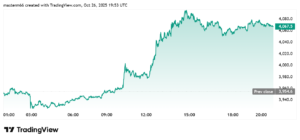Gold for Nations, BTC for the People: A Shift in Monetary Trends
In recent years, the economic landscape has shifted dramatically, with central banks and governments employing various strategies to navigate financial uncertainties. One notable trend is the historic increase in gold purchases by nations, driven by the adoption of easy monetary policies. In 2025, it is projected that 830 tonnes of gold will be acquired annually, with 23 countries increasing their reserves in just the first half of the year. This robust accumulation follows a remarkable three-year streak marked by above-average purchases, with 1,080 tonnes acquired in 2022, 1,051 tonnes in 2023, and 1,089 tonnes in 2024. This momentum has established a 16-year consecutive net purchase trend, the longest on record since central banks transitioned from net sellers to decisive buyers after 2010.
As nations amass gold to bolster their financial security, Bitcoin (BTC) has emerged as a parallel asset for individuals seeking to hedge against economic uncertainty. Long-term holders now control near-record supplies of Bitcoin, while exchange balances are dwindling. This indicates a shift in investor psychology, where BTC is increasingly viewed as a digital counterpart to gold. Just as gold has historically symbolized wealth and stability, BTC is becoming recognized as both a scarce asset and a modern financial refuge, particularly a store of value amidst global monetary easing and heightened risk appetites.
The close relationship between gold and Bitcoin is largely influenced by the changing economic environment characterized by low interest rates and inflation. Central banks’ easy-money policies encourage the accumulation of these alternative assets, as traditional currencies lose purchasing power. Investors are drawn to Bitcoin’s limited supply—capped at 21 million coins—mirroring gold’s finite nature. Consequently, many institutional investors now perceive BTC as a viable hedge against inflation, akin to how governments pile into gold stores.
Furthermore, the growing acceptance of Bitcoin as a legitimate asset class is supported by increasing institutional demand. Major financial institutions and corporations have begun allocating capital to BTC, further validating its place within the investment community. The trend is driven by a younger generation of investors, who are more inclined to embrace digital currencies and view them as a natural evolution of finance. Consequently, Bitcoin’s acceptance has spurred a broader shift towards digital assets, pushing skeptics to reconsider their positions regarding cryptocurrency.
In this changing financial paradigm, gold remains the cornerstone for nations, while Bitcoin increasingly represents the people’s choice for wealth preservation. As countries stockpile gold to safeguard their economic futures, individuals are looking to Bitcoin to escape the tightening grip of traditional financial systems. This democratization of wealth through digital assets not only empowers individual investors but also signifies a potential pivot in global economic dynamics, where power becomes increasingly decentralized.
As we look ahead, the confluence of gold for nations and Bitcoin for the people captures a pivotal moment in the evolution of finance. The systematic accumulation of gold indicates an ongoing strategy for nations amidst economic volatility, while Bitcoin’s rise signifies a burgeoning movement towards individual financial autonomy. Investors from all walks of life are recognizing the importance of diversifying their assets, seeking refuge in both gold and cryptocurrency as they navigate an uncertain future. In this ever-changing landscape, it is vital to stay informed about these trends to make informed investment decisions that can ultimately secure financial well-being.
















